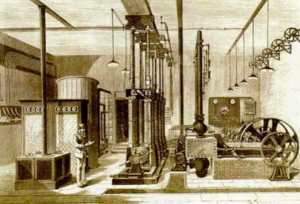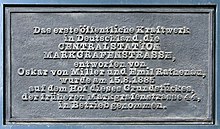Centralstation Markgrafenstrasse
| Centralstation Markgrafenstrasse | |||
|---|---|---|---|
| Contemporary view of the machine room | |||
| location | |||
|
|
|||
| Coordinates | 52 ° 30 '46 " N , 13 ° 23' 38" E | ||
| country |
|
||
| place | Berlin | ||
| Data | |||
| fuel | coal | ||
| power | 540 kW | ||
| owner | Municipal Electricity Works AG | ||
| Start of operations | August 15, 1885 | ||
| Shutdown | 1920s | ||
| boiler | 6th | ||
| Energy fed in 1885 | 0.037 GWh | ||
The Centralstation Markgrafenstrasse in Berlin was the first thermal power plant in Germany to supply electricity to a municipal distribution network and sell it to several customers. The facility stood on Markgrafenstrasse in Berlin's Friedrichstadt district (today part of the Berlin-Mitte district) and was opened in 1885.
prehistory
Siemens & Halske had set up their first power station on Wilhelmstrasse as early as 1882, but it was only used to supply power to the electric carbon arc lamps that went into operation on September 20, 1882 at Potsdamer Platz and Leipziger Strasse . This “machine system consisted of four Siemens dynamo machines driven by Otto gas engines , each with 12 HP (9 kW)”. The operation of this power plant was stopped again in 1886 and the power supply was taken over by the AEG subsidiary that had since been founded.
Establishment of Städtische Elektricitäts-Werke AG
In 1881, the entrepreneur Emil Rathenau acquired the license for the German light bulb patent from Thomas Alva Edison and founded the German Edison Society for Applied Electricity (DEG) in 1883 for commercial use. The company was endowed with a capital of 5 million marks and became the cornerstone for the later AEG .
On February 19, 1884, DEG was granted the concession to supply the inner city of Berlin with electricity. She had the right to use public roads for laying cables. Conversely, she undertook to supply electricity to anyone who so requested. Furthermore, 10% of the profit from the sale of electricity had to be given to the city of Berlin.
For the use of the concession, DEG founded Städtische Elektricitäts-Werke AG with 3 million marks on May 8, 1884 , from which Bewag later emerged.
Construction of the power plant
Städtische Elektricitäts-Werke AG bought the properties at Markgrafenstrasse 44 on Gendarmenmarkt and Mauerstrasse 80 for the construction of power plants.
The Centralstation Markgrafenstrasse started operations on August 15, 1885. The power plant was in operation until 1907 and was then converted into a transformer station. Six steam boilers generated steam with a pressure of 10 atü (10.8 bar) for the operation of six piston steam engines from Borsig , each of which had an output of 110 kW (150 hp). These drove twelve generators that generated direct current with a voltage of 110 V. The total electrical output of the power plant was 540 kW.
The power plant built a little later in Mauerstrasse was almost identical in construction. Other smaller power plants were built in 1890 on Schiffbauerdamm 22 at the corner of Luisenstrasse and in 1899 on Spandauer Strasse between town hall and Molkenmarkt .
Since there was no experience with low-loss power transmission over long distances in the mid-1880s, the first power plants with direct current generators had to be set up in the cities near the consumers. It was not until August 1891 that the three-phase transmission between Lauffen and Frankfurt was the first long-distance line transformed to higher voltages with acceptable levels of efficiency in Germany.
Power supply
With its distribution network, the power plant supplied customers with electricity within a 2.2 km radius. The first major customers were the Schauspielhaus with 150 kW connected load and the Reichsbank with 20 kW. The electricity price was 80 pfennigs / kWh , which would be around 5.79 € today.
The opera house was added in 1887 . In the same year the distribution network was merged with that of the Centralstation Mauerstraße .
After the power supply for the street lighting on Potsdamer Platz and Leipziger Straße had already been taken over in 1886, street lighting on the boulevard Unter den Linden followed in autumn 1888 with the Schupmann candelabra designed by Ludwig Schupmann .
Plaque
A memorial plaque for the power plant is attached to the house at Markgrafenstraße 35 .
literature
- Alois Riedler : Emil Rathenau and the development of the large economy . Julius Springer, Berlin 1916 ( online at archive.org ).
See also
Web links
Individual evidence
- ↑ First electric street lighting. (From Hermann Meyer, Fifty Years at Siemens.) Polytechnisches Journal , 1921, Volume 336, pp. 302–309, accessed on January 2, 2020.
- ^ Herbert Liman: More light . Haude & Spener, Berlin 2000, ISBN 3-7759-0429-8 , pp. 31 .
- ^ Imperial capital and cosmopolitan city. The first electric street lighting in Berlin at Potsdamer Platz. (Collective sheet B 03325 for the Berlin archive of the Archiv Verlag , Braunschweig)
- ^ History. ewerk, accessed on December 10, 2019 (German).
- ^ A b c d e Leonhard Müller: Handbook of the electricity industry. Technical, economic and legal basics . Springer-Verlag, 2013, ISBN 978-3-642-56805-3 , pp. 30 ( google.de ).
- ↑ a b Germany's first electricity power station. Berliner Historische Mitte eV, December 19, 2016, accessed on December 9, 2019 .
- ^ Imperial capital and cosmopolitan city. The “Städtische Elektricitätswerk” in Markgrafenstrasse. (Collective sheet B 05094 on the Berlin archive of the Archiv Verlag , Braunschweig)
- ↑ Alois Riedler : Emil Rathenau and the becoming of the large economy . Julius Springer, Berlin 1916, p. 49–53 ( online on google books [accessed May 6, 2020]).
- ^ Electric lighting in the Berlin Opera House . In: Schweizerische Bauzeitung . tape 10 , no. 11 , September 10, 1887, p. 68 .
- ^ Ludwig Schupmann: Light carrier for electric street lighting in Berlin. In: Centralblatt der Bauverwaltung , Volume 8, 1888, No. 18 (from May 5, 1888), pp. 194–196.


